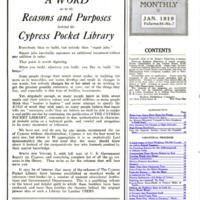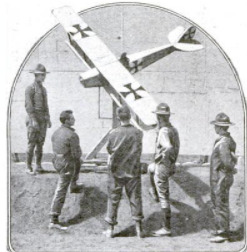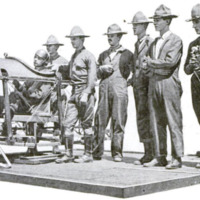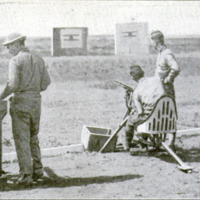Training of U. S. airplane gunners
Item
-
Title (Dublin Core)
-
Training of U. S. airplane gunners
-
Article Title and/or Image Caption (Dublin Core)
-
"Dry Shooting" for Airplane Gunners
-
extracted text (Extract Text)
-
THE Yankee airplane machine-
gunner has to lead the enemy
plane with his aim, precisely
as the duck-shooter has to get his
Tine of fire out ahead of the whizzing
teal to inflict hits. If the airplane
gunner shoots straight at the plane
going past, he hits where the plane
was, but is not, merely because it
requires time for the bullet to go
even 200 yards, and the two planes
are traveling at speeds never touched
by wild fowl.
Wherefore the neophyte in the
machine-gun game is taught first to
make quick allowance, by means of
his “ring sights,” for a plane traveling
past him on a level and at right
angles to the line of fire, and then
later to lead correctly for the plane
traveling in various directions with
relation to his line of fire.
Aiming Ahead of Target
The student is seated in a pivoted
plane chassis which sways at the
slightest movement. It is fitted with
the service ring sight, by which auto-
matic allowance is made to put the line
of fire ahead of the enemy plane, while
still aiming straight at the pilot
of the other ship. By
aiming through
the side of
the rear
ring, the gunner can still aim directly
at the other pilot, but is really
pointing the gun ahead of the other
plane, just as one can do with a wind-
gage sight on a military rifle. a
Use of Miniature Airplanes
With the students seated behind
dummy guns, the crews working
the targets operate the miniature
planes mounted on pedestals to simu-
late full-sized planes at a distance,
traveling at various angles. The
student becomes accustomed to lay-
ing the sight of his gun on the plane
and making the allowance necessary
to inflict hits.
The second stage is with actual
machine-guns and ball cartridge.
The guns are mounted to simulate
machine-gun mounts on a plane,
and the plane targets are operated by
a hidden and protected crew, as in
the first practice.
The guns, how-
ever, do not hit
the planes, which
are stationary.
They hit a target to the right or left
of the plane, the change in position
of the shot group being made, of
course, by the necessary “lead” to hit
a fast moving plane.
The distance from the plane
to various spots on the target is
known and charted out; so, with the
dummy plane at a given distance and
“traveling” at the angle it is given by
the pit serew, the position of the shot
strike on the target to the right or
left shows immediately whether or not
a real plane would have been hit
whether the judgment and lead used
was correct to hit. '-
More advanced courses include firing
from a high-speed hydroplane or sea-
sled at targets in the water, and firing
from planes at objects on the water
to show bullet strike.
-
Contributor (Dublin Core)
-
Captain E. C. Crossman (Article writer)
-
International Film (Images' copyright)
-
Language (Dublin Core)
-
eng
-
Date Issued (Dublin Core)
-
1919-01
-
pages (Bibliographic Ontology)
-
13-14
-
Rights (Dublin Core)
-
Public domain (Google digitized)
-
Archived by (Dublin Core)
-
Davide Donà
-
Marco Bortolami (editor)
 Popular Science Monthly, v. 94, n. 1, 1919
Popular Science Monthly, v. 94, n. 1, 1919






